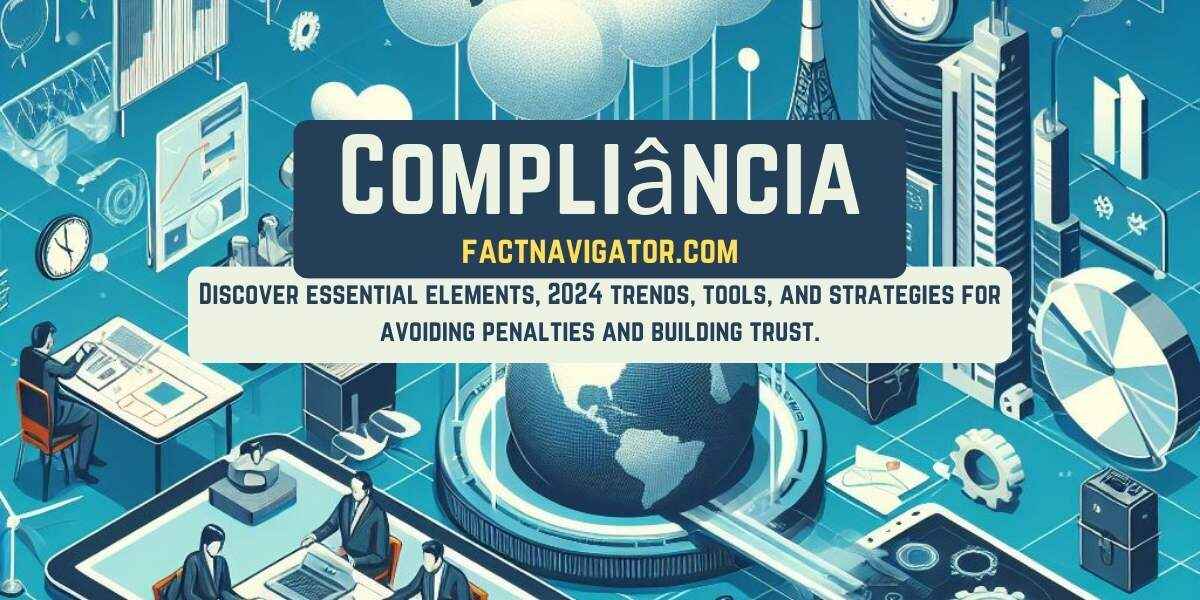Compliância Guide: Best Practices & Trends 2024

1. What is Compliância?
In the simplest terms, Compliância means adhering to established rules, regulations, standards, or laws. These guidelines exist at multiple levels – industry-specific regulations, governmental laws, and even internal company policies.
True Compliância extends beyond simply ‘checking boxes.’ It involves a deep understanding of the rationale behind the requirements and proactive integration of compliant practices into all aspects of business operation.
The Importance of Compliância for Businesses
Here’s why companies need a focus on “compliância”:
Avoiding Penalties and Fines
Non-Compliância can result in substantial financial penalties, from regulatory fines to legal fees. These costs hurt the bottom line and disrupt operations.
Example: In 2022, a multinational technology company faced massive GDPR fines for inadequate handling of consumer data. This resulted in hefty monetary penalties and significant damage to their reputation.
Protecting Reputation and Brand Value
Compliância lapses erode consumer trust. Scandals, negative press, and public perception of wrongdoing harm a company’s reputation and make it more difficult to attract customers and top talent.
Example: Consider the impact a major data breach or environmental violation would have on a brand built upon trust and security.
Fostering a Culture of Integrity
A strong Compliância program creates a company culture where ethics and adherence to rules are the norm. When employees understand the ‘why’ behind Compliância, they’re more likely to make responsible choices that align with company values.
This culture of integrity positively impacts decision-making at every level, reducing risk and promoting long-term sustainability.
Key Takeaways to Emphasize
- “Compliância” isn’t just about avoiding trouble; it’s about doing business the right way.
- Businesses that prioritize Compliance often gain a competitive advantage due to their reputation for trustworthiness and responsibility.
2. Types of Compliância
Businesses navigate a maze of regulations varying based on industry, location, and the types of data handled. Let’s delve into key Compliância areas:
Industry-Specific Compliância
- Financial Compliância (e.g., SOX, Dodd-Frank): The financial industry’s integrity hinges on strict Compliance. The Sarbanes-Oxley Act (SOX) mandates rigorous internal controls to ensure financial reporting accuracy and prevent fraudulent activities. The Dodd-Frank Act, enacted after the 2008 financial crisis, was designed to strengthen the oversight of large financial institutions, enhance consumer protection, and increase transparency within financial markets.
- Healthcare Compliância (e.g., HIPAA, HITECH): Protecting sensitive patient health information is paramount in the healthcare industry. HIPAA (Health Insurance Portability and Accountability Act) sets the baseline for privacy and security of patient data. The HITECH Act (Health Information Technology for Economic and Clinical Health Act) strengthens HIPAA, promotes the adoption of electronic health records (EHRs), and increases accountability for Compliância breaches.
- Environmental Compliância (e.g., EPA, Clean Air Act): Environmental regulations are crucial for minimizing a business’s impact on the environment. The Environmental Protection Agency (EPA) enforces laws like the Clean Air Act, which aims to curb air pollution, and other statutes governing waste disposal, water quality, and resource conservation. Companies must understand their environmental obligations and adopt practices to mitigate their footprint.
Data Privacy Compliância
- GDPR (General Data Protection Regulation): The EU’s GDPR serves as an international gold standard for data privacy. It emphasizes principles like user consent, providing individuals with rights over their data (such as access, rectification, and erasure), promoting transparency in data processing, and holding organizations accountable.
- CCPA (California Consumer Privacy Act): The CCPA grants California residents a range of rights over their personal information held by businesses. This includes the right to know what data is collected, to opt out of having their data sold, and to request the deletion of their data.
- Other Emerging Privacy Regulations: Data privacy is a rapidly evolving landscape. Other countries like Brazil (with their LGPD) and various Asian nations are adopting similar privacy laws. Staying abreast of these regulations is crucial for companies with a global presence or with customers in those jurisdictions.
Cybersecurity Compliância
- NIST Cybersecurity Framework: This widely respected framework gives businesses a structure for managing cybersecurity risks. Its core functions – Identify, Protect, Detect, Respond, and Recover – provide a comprehensive approach for safeguarding information assets.
- ISO 27001: This international standard establishes requirements for implementing an Information Security Management System (ISMS). Achieving ISO 27001 certification shows stakeholders that an organization prioritizes data security and has a systematic approach to managing risks.
- PCI DSS (Payment Card Industry Data Security Standard): Organizations processing credit or debit card payments must adhere to the PCI DSS’s security measures. This includes a combination of technical safeguards (e.g., encryption, firewalls) and operational procedures to protect cardholder data and prevent fraud.
Also Read: Ladder for booker t washington strathaven.s-lanark.sch.uk
3. Key Elements of a Successful Compliância Program
A robust Compliância program is not just a set of documents but a dynamic system woven into a company’s operations. Here’s a breakdown of essential components:
Risk Assessment and Management
- Proactive Identification: Compliância starts with understanding the specific risks a business faces due to its industry, operations, and the data it handles. This includes regulatory risks and those arising from potential ethical lapses.
- Risk Prioritization: Not all risks are equal. Analyze the likelihood and potential impact of identified risks to allocate resources for effective mitigation.
- Ongoing Monitoring: The risk landscape evolves. Implement processes for continual re-evaluation of risks to stay ahead of emerging threats.
Policies and Procedures
- Clear and Concise Documentation: Policies and procedures should be written in plain language, avoiding excessive jargon. They must clearly define expectations and responsibilities.
- Tailored to the Organization: Don’t just use generic templates. Adapt policies and procedures to reflect a company’s unique operations and risks.
- Regular Review and Update: Regulations and business practices change. Schedule regular reviews to ensure policies align with current legal requirements and incorporate lessons learned.
Employee Training and Awareness
- Engaging Training Methods: Traditional lectures aren’t enough. Use interactive scenarios, gamification, and real-world examples to make Compliância resonate with employees.
- Beyond Initial Onboarding: Compliância training should be a continuous process, reinforcing key concepts throughout employees’ tenure.
- Tailored to Roles: Training must consider an employee’s specific job responsibilities and the risks they’re likely to encounter.
Monitoring and Auditing
- Internal Controls: Design processes with checks and balances to identify potential Compliância issues early. This includes regular reporting and analysis of relevant data.
- Periodic Assessments: Conduct internal audits or utilize external experts to objectively evaluate Compliance adherence and identify areas for improvement.
- Documentation is Key: Thoroughly document monitoring and auditing findings, along with any corrective actions, to demonstrate a robust Compliância program.
Incident Response Plan
- Preparing for the Unexpected: Despite best efforts, breaches or violations can occur. Have a detailed response plan defining roles, reporting procedures, and steps for investigation and mitigation.
- Transparency as Appropriate: Involve legal counsel early. Determine when and how to disclose an incident to regulatory bodies or affected individuals.
- Learn and Improve: Every incident offers valuable lessons. Analyze the root causes and update your Compliância program to prevent similar events.
4. Trends and Challenges in Compliância for 2024
The Compliância landscape is ever-evolving. Here’s what businesses need to be aware of in 2024 and beyond:
Increased Regulatory Complexity
- Global Fragmentation: While major regulations like GDPR have a broad effect, there’s a growing patchwork of country and state-level privacy laws. This creates challenges for businesses operating across multiple jurisdictions.
- Emerging Areas: Regulations are developing in new areas like the use of artificial intelligence, cryptocurrency, and even the metaverse. Proactive monitoring is key to staying ahead.
- Focus on Sustainability: More ESG (Environmental, Social, Governance) reporting requirements are emerging, requiring businesses to track and disclose their impact beyond just financial metrics.
Remote Work and Hybrid Workforces
- Data Security Challenges: Dispersed workforces increase the cybersecurity risk profile. Enforce strong data encryption, access controls, and employee training on handling sensitive information remotely.
- Monitoring Difficulties: It’s more difficult to physically monitor Compliância practices in a remote setting. Companies may need to invest in technology solutions or adjust internal auditing strategies.
- Jurisdictional Variations: Remote employees may be located in areas with differing labor laws and regulations, which adds a layer of complexity for HR Compliância.
The Rise of Artificial Intelligence (AI) and Compliância
- AI as a Tool: AI can be leveraged for tasks like risk assessment, data analysis, and regulatory change tracking. Companies should explore these possibilities to improve efficiency.
- AI as a Risk: AI systems themselves need to be compliant. Ensure algorithms are free from bias, meet privacy requirements, and operate with transparency and accountability.
- Evolving Regulatory Landscape: Expect new regulations specifically regarding the ethical development and use of AI, particularly in areas like decision-making and data processing.
Focus on Ethical Compliância
- Beyond Just the Law: Compliância isn’t just about avoiding penalties. Customers and stakeholders increasingly expect businesses to operate ethically, even in areas without clear-cut regulations.
- Building Trust: An ethical Compliância program promotes long-term trust in a company’s brand and reduces the potential for reputational damage down the line.
- Proactive Culture: Promote a workplace culture where employees feel empowered to raise concerns and speak up about potential ethical lapses, not just potential regulatory violations.
5. Tools and Technologies to Support Compliância
The right technology stack can transform your Compliância program from reactive to proactive, saving time and reducing risk. Here’s an overview of key tools:
Compliância Management Software
- Centralized Hub: Dedicated Compliância management platforms offer a single dashboard for tracking regulatory requirements, policies, training, incidents, and more.
- Workflow Automation: Automate tasks like policy distribution, employee attestations, and task reminders to avoid manual errors and free up time for strategic Compliância work.
- Reporting and Dashboards: Real-time insights into Compliance metrics help identify areas of concern and demonstrate program effectiveness.
- Vendor Management: Some solutions include features to streamline third-party assessments, critical for supply chain risk analysis in areas like cybersecurity and data privacy.
Data Analytics for Compliância Monitoring
- Anomaly Detection: Analyze large datasets (e.g., transaction data, employee communications) to detect patterns that could indicate potential non-Compliância, such as unusual financial activity or suspicious communications.
- Predictive Analytics: By applying advanced statistical modeling and potentially AI techniques, identify high-risk areas or predict future Compliance gaps, allowing for proactive intervention.
- Visualization Tools: Communicate complex Compliância data in easy-to-understand dashboards, helping stakeholders at all levels understand the importance of Compliância.
Automated Risk Assessments
- Standardized and Scalable: Implement risk assessment tools that guide users through a consistent process and apply pre-configured scoring methodologies.
- Continuous Risk Monitoring: Some solutions enable ongoing risk tracking tied to key metrics and data feeds, allowing for a shift from periodic snapshots to real-time risk assessment.
- Integration Capabilities: Ideally, risk assessment tools should integrate with broader Compliância software for a holistic view of a company’s risk profile.
Key Considerations When Choosing Technology:
- Industry-Specific Needs: Ensure the chosen tools have relevant features for your sector’s regulatory landscape.
- Data Compatibility: Your tools should easily integrate with existing data sources and systems.
- Vendor Reputation: Prioritize solution providers with a proven track record, especially when dealing with sensitive data.
Conclusion: Compliância – An Ever-Evolving Journey
The world of “compliância” is not static. New regulations emerge, technologies transform businesses, and expectations of ethical conduct evolve. A successful Compliância program is not about achieving a checklist and then moving on. It’s fundamentally about:
- Resilience: Creating a company culture and operational systems that adapt smoothly to changing requirements.
- Continuous Learning: Regularly monitoring industry news, regulatory updates, and best practices to stay ahead of emerging risks.
- Technology as an Enabler: Investing in the right technology tools to automate, streamline, and provide insights into your Compliância processes.
Why Prioritize Proactive Compliância?
- Mitigating Financial and Reputational Risk: Avoiding costly fines, penalties, and the damage to trust that follows Compliância breaches.
- Building a Competitive Edge: Businesses known for prioritizing “compliância” are viewed as reliable and trustworthy, attracting customers and partners.
- Fostering Ethical Integrity: A strong Compliância program aligns with a company’s values, influencing positive decision-making and behavior at all levels.
Remember, Compliância is an investment, not merely a cost. Proactive “compliância” fosters a sustainable and responsible business, poised for long-term success.






